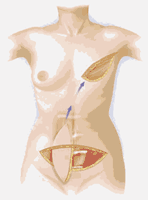Breast reconstruction
Editors-In-Chief: Martin I. Newman, M.D., FACS, Cleveland Clinic Florida, [1]; Michel C. Samson, M.D., FRCSC, FACS [2]
Overview
Breast reconstruction is the rebuilding of a breast, usually in women. It involves using autologous tissue or prosthetic material to construct a natural-looking breast. Often this includes the reformation of a natural-looking areola and nipple. This procedure involves the use of implants or relocated flaps of the patient's own tissue.
The primary part of the procedure can often be carried out immediately following the mastectomy. As with many other surgeries, those with significant medical comorbidities (high blood pressure, obese, diabetes) individuals who smoke are higher-risk candidates. Surgeons may choose to perform delayed reconstruction to decrease this risk. Patients expected to receive external beam radiation as part of their adjuvant treatment are also commonly considered for delayed autologous reconstruction due to significantly higher complication rates with tissue expander-implant techniques in those patients.
Breast reconstruction is a large undertaking that usually takes multiple operations. Sometimes these follow-up surgeries are spread out over weeks or months. If an implant is used, the individual runs the same risks and complications as those who use them for breast augmentation but has higher rates of capsular contracture (tightening or hardening of the scar tissue around the implant) and revisional surgeries.
In 1998, the Women's Health and Cancer Rights Act was passed mandating insurance coverage for breast reconstruction in the United States. Prior to this, many insurance carriers did not cover breast reconstructive surgery as they considered it cosmetic in nature. The law is also known as "Janet's Law", named for Janet Franquet, a breast cancer patient who fought her insurance carrier with Dr. Todd Wider, a New York plastic surgeon who helped lobby for the legislation with Senator Al D'Amato. The act mandates insurance coverage for the surgery of the affected breast and also the contralateral side for purposes of symmetry1.
1. Find more information on mastectomies.
Techniques
There are many methods for breast reconstruction. The two most common are:
- Tissue Expander - Breast implants This is the most common technique used in worldwide. The surgeon inserts a tissue expander, a temporary silastic implant, beneath a pocket under the pectoralis major and serratus anterior muscles of the chest wall. The pectoral muscles may be released along its inferior edge to allow a larger, more supple pocket for the expander at the expense of thinner lower pole soft tissue coverage. The use of acellular human or animal dermal grafts have been described as an onlay patch to increase coverage of the implant when the pectoral muscle is released, which purports to improve both functional and aesthtic outcomes of implant-expander breast reconstruction. [1] [2]
- In a process that can take weeks or months, saline solution is percutaneously injected to progressively expand the overlaying tissue (see tissue expansion). Once the expander has reached an acceptable size, it may be removed and replaced with a more permanent implant. Reconstruction of the areola and nipple are performed in a separate operation after the skin has stretched to its final size.
- Flap reconstruction The second most common procedure uses tissue from other parts of the patient's body, such as the back, buttocks, thigh or abdomen. This procedure may be performed by leaving the donor tissue connected to the original site to retain its blood supply (the vessels are tunnelled beneath the skin surface to the new site) or it may be cut off and new blood supply may be connected.
- The latissimus dorsi muscle flap is the donor tissue available on the back. It is a large flat muscle which can be employed without significant loss of function. It can be moved into the breast defect still attached to its blood supply under the arm pit (axilla). A latissimus flap is usually used to recruit soft-tissue coverage over an underlying implant. Enough volume can be recruited occasionally to reconstruct small breasts without an implant.
- Abdominal flaps The abdominal flap for breast reconstruction is the TRAM flap or its technically distinct variants the DIEP/SIEP flaps. Both use the abdominal tissue between the umbilicus and the pubis. The DIEP and free-TRAM flaps require advanced microsurgical technique and are less common as a result. Both can provide enough tissue to reconstruct large breasts. The contour of the lower abdomen is reliably improved by these procedures which remove the same tissue as an abdominoplasty (tummy tuck.) TRAM flap procedures may weaken the abdominal muscles, but are usually tolerated well in most patients. To prevent muscle weakness and incisional hernias, the portion of abdominal wall exposed by reflection of the rectus abdominis muscle may be strengthened by a piece of surgical mesh placed over the defect and sutured in place. The DIEP (deep inferior epigastric perforator flap) and SIEP (superficial inferior epigastric perforator flap) require precise dissection of small perforating vessels through the rectus muscle, and purport the advantage of less weakening of the abdominal wall.
| The TRAM Flap Procedure | ||
|---|---|---|
 |
 |
 |
| Identification of the target and donor sites | Raising the flap and transposing it to the target site | The result of the reconstruction |
Other considerations
Nipple reconstruction is usually delayed until after the breast mound reconstruction is completed so that the positioning can be planned precisely. There are several methods of reconstructing the nipple-areolar complex, including:
- Nipple-Areolar Composite Graft (Sharing) - if the contralateral breast has not been reconstructed and the nipple and areolar are sufficiently large, tissue may be harvested and used to recreate the nipple-areolar complex on the reconstructed side.
- Local Tissue Flaps - a nipple may be created by raising a small flap in the target area and producing a raised mound of skin. To create an areola, a circular incision may be made around the new nipple and sutured back again. The nipple and areolar region may then be tattooed to produce a realistic colour match with the contralateral breast.
- Local Tissue Flaps With Use of AlloDerm - as above, a nipple may be created by raising a small flap in the target area and producing a raised mound of skin. AlloDerm (cadaveric dermis) can then be inserted into the core of the new nipple acting like a "strut" which may help maintain the projection of the nipple for a longer period of time. The nipple and areolar region may then be tattooed later.[3]
One of the challenges in breast reconstruction is to match the reconstructed breast to the mature breast on the other side (often fairly 'ptotic' - droopy.) This often requires a lift (mastopexy), reduction, or augmentation of the other breast.
- ↑ Breuing KH, Warren SM. Immediate bilateral breast reconstruction with implants and inferolateral AlloDerm slings. Ann Plast Surg. 2005 Sep;55(3):232-9. PMID: 16106158
- ↑ Salzberg CA. Nonexpansive immediate breast reconstruction using human acellular tissue matrix graft (AlloDerm). Ann Plast Surg. 2006 Jul;57(1):1-5. PMID 16799299
- ↑ Charles E. Garramone, D.O.; Benjamin Lam, D.O.:"Use of AlloDerm in Primary Nipple Reconstruction to Improve Long-Term Nipple Projection" Plastic & Reconstructive Surgery Journal, May 2007, Volume 119, Issue 6, PMID: 17440338
Follow-up and Recovery
Recovery from implant-based reconstruction is generally faster than with flap-based reconstructions, but both take at least three to six weeks to recover and both require follow-up surgeries in order to construct a new areola and nipple. All recipients of these operations should refrain from strenuous sports, overhead lifting and sexual activity during the recovery period (three to six weeks). TRAM flap patients can show abdominal muscle weakness on EMG studies, but clinically most patients return to normal activities after recovery.
There is little information about upper body exercise post-mastectomy. Issues such as simple mastectomy, mastectomy with reconstruction, mastectomy with lymph node excision and reconstruction all factor into limitations to amount and extent of upper body exercise. Generally, cardiac exercise (treadmill, walking, etc.) are approved for rehabilitation post-surgery and for weight control. Women who have undergone breast reconstruction must still be followed for local or regional recurrence of their cancer with manual exams of the breast/chest wall and axilla.
See also
External links
- Breast Reconstruction Following Breast Removal from the American Society of Plastic Surgeons
- In-depth breast reconstruction discussion from the University of Iowa
- National Cancer Institute breast cancer page
- NCI online Breast Cancer Risk Assessment Tool for patients
- Surgery Choices for Women with Early-Stage Breast Cancer
- US Dept. of Labor - Women's Health & Cancer Rights Act of 1998
|
Cleft lip and palate Microchapters |
|
Diagnosis |
|---|
|
Treatment |
|
Case Studies |
|
Breast reconstruction On the Web |
|
American Roentgen Ray Society Images of Breast reconstruction |